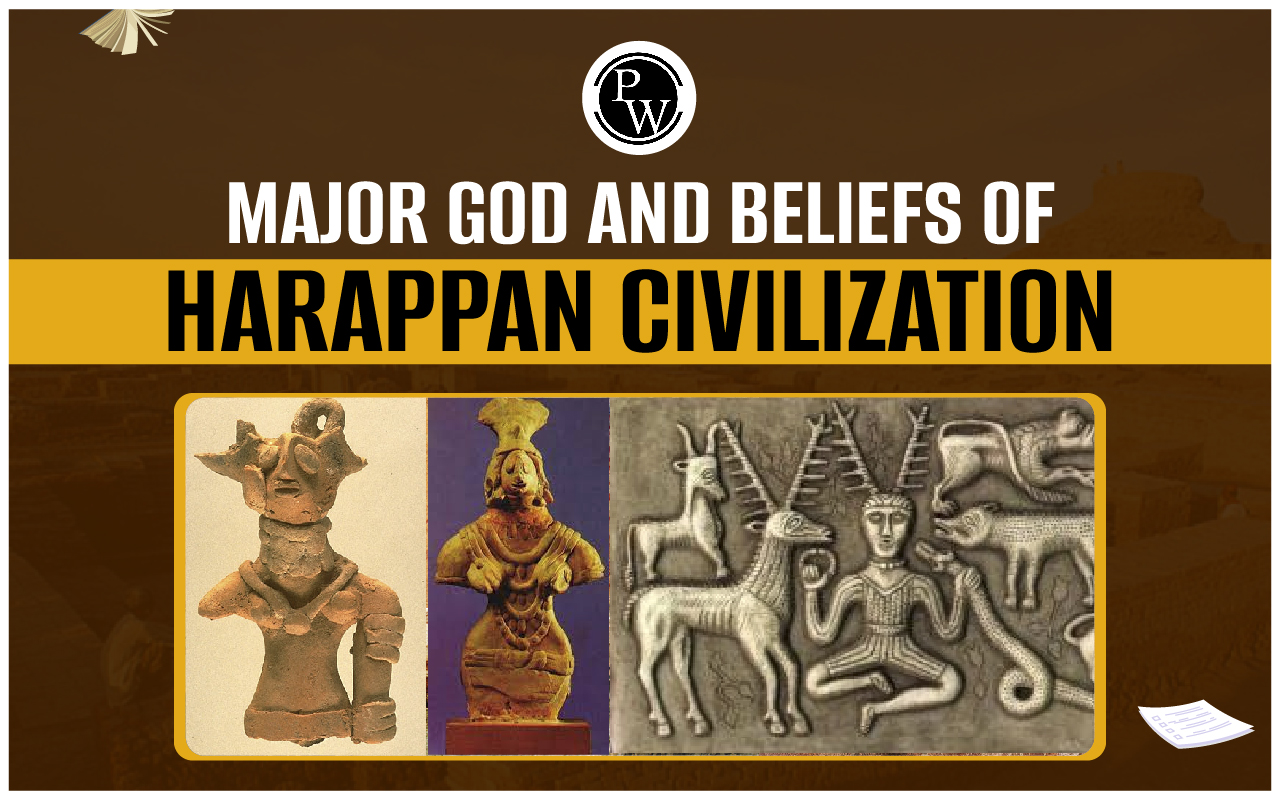

Major Gods and Beliefs of Harappan Civilization: The Major God and Beliefs of Harappan Civilization included the worship of Pashupati or Proto Shiva, who was the chief deity. Archaeologists discovered the Pashupati seal in Mohenjo Daro, depicting a three-faced figure seated cross-legged on a throne, surrounded by animals like an elephant, tiger, buffalo, rhinoceros, and two deer. This seal, also known as the Mahayogi seal, is one of the oldest representations of Lord Shiva, known as 'Mahayogi' and 'Pashupati.' Sir John Marshall, who led the excavations, named the figure Proto Shiva. The Harappa and Mohenjo Daro sites, now in Pakistan, were key locations of the Indus Valley Civilization. The Pashupati seal is preserved at the National Museum in New Delhi. Besides Pashupati, the people also worshiped Mother Goddess, Neem, Peepal, the Sun, Fire, Earth, and Water, showcasing the major gods and beliefs of the Harappan Civilization.
Major God and Beliefs of Harappan Civilization
The Harappan society was deeply religious, and although no temples or statues of gods have been found, various figurines and seals give us insights into their religious beliefs.Worship of Mother Goddess
A key feature of Harappan religion was the worship of the Mother Goddess. Numerous terracotta figurines believed to represent the Mother Goddess have been found. These figures often wear sarees, necklaces, and waistbands. One notable seal shows a female figure upside down with a tree sprouting from her womb, symbolizing fertility. Other seals depict women with raised arms, suggesting some form of sacrifice. The worship of the Mother Goddess, seen as the source of creation and energy, is evident from these images.Worship of Male God
Harappans also worshiped a male god. A prominent seal shows a male figure, possibly an early form of Shiva, meditating with a buffalo horn headgear, surrounded by animals. This image relates to the later concept of Pashupati, or the master of animals. The presence of bulls and oxen on seals suggests indirect worship of Shiva.Worship of Animals and Plants
Animal worship was common in Harappan religious practices. Elephants, rhinoceroses, tigers, and bulls were frequently depicted. Serpent and bull worship were also prevalent, with the bull often associated with Shiva. Trees like the peepal and possibly the neem and banyan were worshiped, as they were believed to house spirits. Seals showing deities standing under trees or between branches indicate tree worship.Worship of Stones and Objects
Harappans worshiped stones, often in the form of linga (male genital organ) and yoni (female genital organ), symbolizing Shiva and Shakti. A terracotta piece from Kalibangan shows these symbols together.Practice of Yoga
Yoga was significant in Harappan culture, both for physical exercise and as a religious practice. Many terracotta figurines show people in various yogic postures.Worship of Sun, Fire, and Water
Fire worship was evident from the fire altars found at Kalibangan, Lothal, and Banwali. Symbols like the swastika and chakra suggest sun worship. Water was highly revered for its purifying qualities, as seen from the numerous wells, tanks, and public baths.Disposal of the Dead
The Harappans practiced different methods of disposing of the dead:- Cremation was common, with ashes sometimes placed in urns.
- Leaving the dead in jungles for animals and birds to consume.
- Burial, sometimes with earthen pots containing food grains or ornaments.
Seals of the Harappan Civilization
Seals were small tablets used by the Harappan people, discovered in large numbers at major archaeological sites. These seals often feature pictures and writing, possibly representing the names and titles of owners or traders.Shapes and Materials
- Shapes: Seals were generally square or rectangular but also came in unique shapes like crescent, cylindrical, cubical, round, hexagonal, and triangular.
- Materials: Most seals were made from chlorite or French chalk, in colors like off-white, black, grey, or dull yellow. Some seals were made of silver, faience, and calcite.
Motifs and Designs
The seals featured a variety of motifs, including:- Animals: Elephant, tiger, antelope, humped bull, buffalo, unicorn, hare, and rhinoceros.
- Composite Animals: Imaginary creatures combining features of different animals.
- Human Figures and Plants: Representations of people and vegetation also appeared on seals.
Major Gods and Beliefs of Harappan Civilization FAQs
Who was the major god worshiped by the Harappan civilization?
What is the Pashupati seal?
Did the Harappan people worship female deities?
What animals were commonly worshiped in the Harappan civilization?
How did the Harappan civilization dispose of their dead?












